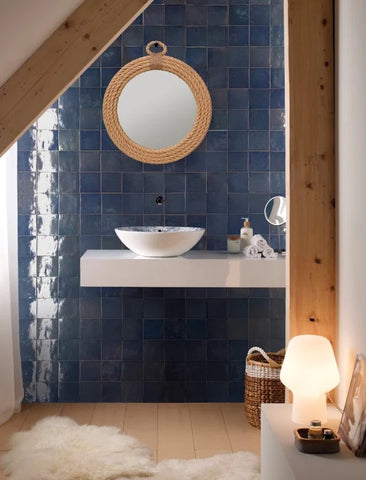What is the Difference Between Ceramic and Porcelain Tile?
While shopping for new tiles can be fun, the choices can quickly become overwhelming when comparing the vast array of options out there. Ceramic and porcelain are two of the most popular and widely used types of tile. At first glance, these two materials look pretty similar. However, they both have unique qualities and shine in different applications. So, what is the difference between ceramic and porcelain tile, and which is the best fit for your space?
Let's explore the distinctions so you can make an informed decision before your next tiling project. To help you out, we've put together an in-depth list of the top eight differences between porcelain and ceramic tile. You’re going to be a tile pro soon enough!
1. Composition and Production
The most apparent difference between ceramic and porcelain tiles lies in their composition and production process.
Ceramic tiles are made from a mixture of clay, minerals, and water. The clay is shaped into tiles and fired at a high temperature in a kiln.
Porcelain tiles are made from denser clay fired at an even higher temperature, making them more durable and less porous than ceramic.
2. Porosity and Water Absorption
Ceramic tiles, while durable, have a noticeably higher water absorption rate than porcelain tiles, typically ranging from 3 to 7 percent.

Pictured: Porcelain Tile from Our Encanto Collection
Ceramic tiles, while still durable, have a noticeably higher water absorption rate, typically ranging from 3% to 7%.
Porcelain tiles have a low water absorption rate that is usually less than 0.5 percent, making them an excellent choice for areas prone to moisture or high humidity, such as bathrooms, kitchens, and outdoor spaces.
3. Durability and Strength
Ceramic tiles, while strong, may be more susceptible to damage in high-traffic areas and are best suited for moderate-traffic spaces. They’re great for wall tiles, backsplashes, showers, and residential floor tiles. However, they may not be the best fit for a busy office building lobby.
Porcelain tiles are known for their exceptional durability and strength. The high firing temperature during production and compact composition make them resistant to cracking, chipping, and wear. Porcelain tiles can withstand heavy foot traffic and are suitable for both residential and commercial applications.
Our takeaway? Ceramic tiles are best suited for residential and wall applications. Thanks to their durable, nonporous construction, porcelain tiles are great for residential, commercial, and even outdoor use.

Pictured: Bathroom Tiled With Our Imperial Midnight Ceramic 4x4 Wall Tile
4. Design and Appearance
Both ceramic and porcelain tiles offer a wide range of design options and aesthetics. Ceramic tiles come in various colors, glazes, shapes, and painted patterns, making them versatile for different design preferences.

Pictured: Imperial 4x4 Ceramic Tiles in Desert
Porcelain tiles often mimic the look of natural stone, wood, and other high-end materials. With porcelain, you can achieve your desired look at a lower price point with the added benefit of easy maintenance and long-lasting durability.
The design possibilities for both types of tiles are extensive, with either option allowing you to create your dream space.
Here's some fantastic bathroom design inspiration from one of our favorites, HGTV.
5. Pricing
In general, ceramic tiles are more affordable than porcelain tiles. The production process for ceramic tiles is less complex and requires lower firing temperatures, resulting in a more budget-friendly option. Due to their denser composition and higher firing temperatures, porcelain tiles tend to be pricier. The cost difference may influence your decision based on your project budget and specific needs.
6. Installation and Maintenance
Installing ceramic and porcelain tiles follows a similar process, involving adhesive or mortar to secure the tiles to the floor or wall. However, cutting and shaping porcelain tiles during installation can be more challenging and may require specialized tools due to their density and hardness.
Wondering how to install a tile floor? Here's a step-by-step guide from The Home Depot.
In terms of maintenance, both ceramic and porcelain tiles are relatively easy to clean and maintain. There's no sealing needed on either type of tile, and they easily wipe clean. Regular sweeping and mopping will keep them looking new. However, the lower porosity of porcelain tiles means they are even less susceptible to staining and require less maintenance in the long run.
7. Design Applications
Both ceramic and porcelain tiles are suitable for various design styles and projects. Ceramic tiles are commonly used for walls, countertops, or locations with light to moderate foot traffic areas. They are an excellent choice for indoor spaces.

Pictured: Imperial Pearl Ceramic Wall Tile 4x4
Due to their durability and resistance to water and breakage, porcelain tiles are ideal for flooring, bathrooms, kitchens, outdoor areas, and high-traffic commercial spaces.
8. Environmental Impact
From an environmental perspective, ceramic and porcelain tiles are both relatively eco-friendly. These two tile types are made from natural materials. Thanks to modern production processes, these materials minimize waste and energy consumption. Additionally, both tiles can be recycled and reused, which reduces their overall environmental impact. Regardless of which material you choose for your next interior design project, you can feel good about your purchase!
So, What is the Difference Between Ceramic and Porcelain Tile?
While ceramic and porcelain tiles share similarities in appearance and design options, their composition, durability, water absorption, and pricing differ significantly. Ceramic tiles are a cost-effective option suitable for various in-home locations with moderate foot traffic. On the other hand, porcelain tiles are a top choice for areas exposed to moisture and heavy use due to their strength and low porosity.
Understanding these differences will help you choose the best tile for your specific project, ensuring a beautiful and functional result that suits your needs and preferences. So, shop the tiles, grab the tools, and get to tiling!

